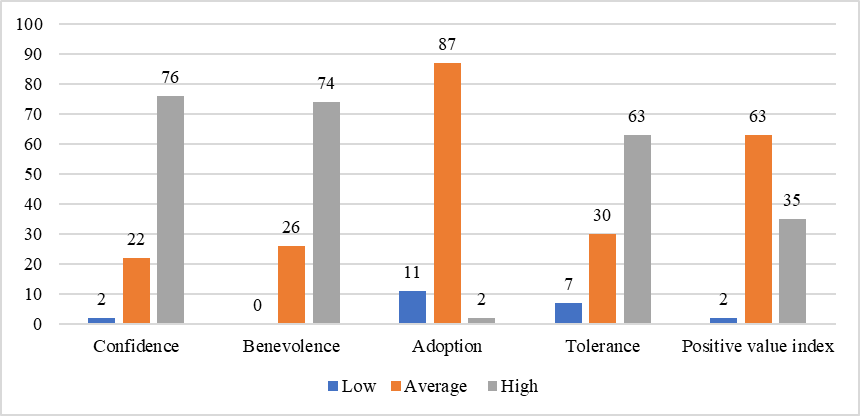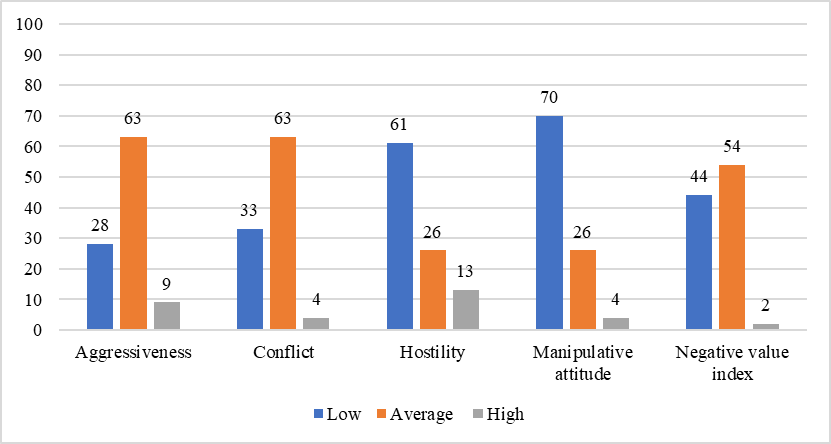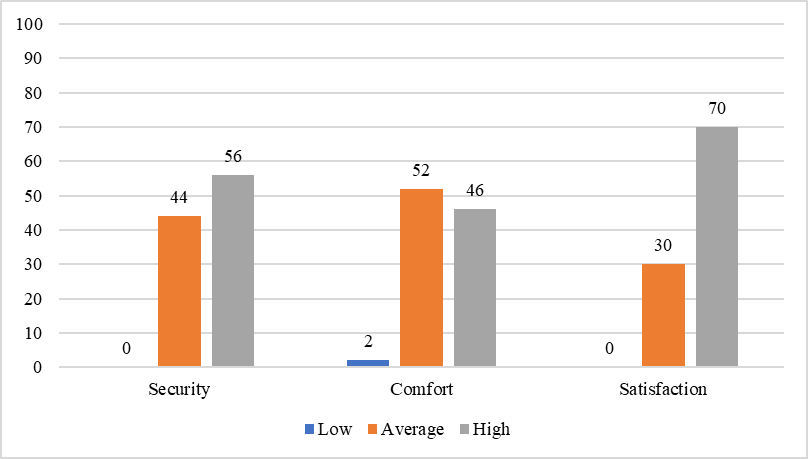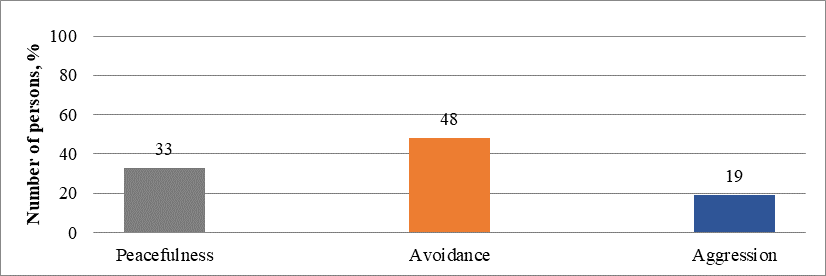Abstract
Today, the topic of psychologically safe communication skills among adolescents has been little studied, so the purpose of the study is to identify the level of psychologically safe communication skills among adolescents in a children and youth center. The correlations of indicators of the quality of interpersonal communication with the criteria of psychologically safe educational environment were established using the method of Pearson. The results show that adolescents at the middle level have significantly significant correlations between the qualities of communication and the criteria of a psychologically safe educational environment, such as direct connections between “trust” and “satisfaction” with the criteria “security” and “comfort”, “trust” and “satisfaction”, the relationship between tolerance and all three criteria. Each negative quality of communication (aggression, conflict, hostility, manipulative attitude) has a negative correlation with the criterion of “security”, which increases with a decrease in these qualities. The manipulative attitude has no connection with the criterion of comfort and satisfaction. This quality does not cause concern to adolescents. The positive quality “acceptance” is negatively correlated with security, adolescents feel more secure if they do not fully accept group characteristics, they are more critical. At the same time, there are reliably significant positive correlations between the strategies of psychological defense and the qualities of communication: the higher the peacefulness, the higher the benevolence, trust, tolerance; the higher the indicators of protection by aggression, the higher the aggressiveness, hostility, conflict, manipulative relations.
Keywords: Additional education, adolescents, communication, psychological safety, personal-confidential communication, reference significance
Introduction
Nowadays communication and its quality remain a popular problem in scientific research. For decades, sociologists, psychologists, teachers thoroughly study the process of communication in a teenage environment. Their studies have revealed that for adolescents their leading activity consists precisely in communication between peers, and is, in turn, a formative link in the formation of personality in education (Filonenko, 2008; Smirnov, 2013; Sokol & Serper, 2017; Zagvyazinskii, 2016). At the stage of transition from childhood to adulthood, there is a sharp jump in physical and mental development, inevitably leading to an adolescent crisis. A way out of the crisis is inevitable and should lead to development. However, for adolescents, the vector of their mental development may be different (functional or dysfunctional) depending on the social environment (Smortchkova, 2017). Emancipation from adults and the search for a reference group of communication indicate the growing need for a teenager to express himself, from the position of an adult person who feels the ability to independently build relationships with society. The peer group is a formative source, but the relationships built by a teenager may not always be positive, especially if a teenager does not have the skills of constructive, psychologically safe communication based on trust, satisfaction, acceptance and tolerance. Knowledge of the quality of communication in a teenager will help to determine whether it is psychologically safe, and form the skills of psychologically safe communication in the reference-significant environment for a teenager in a children and youth center in a timely manner.
These positions determined the purpose of our study. The purpose is to identify the formation of psychologically safe communication skills among adolescents of the youth center. Experts substantiate the timely age peculiarity of adolescents – the need for interpersonal communication with peers. A personality is formed in mastering this new social situation (Obukhova, 2009).
In the process of building relationships, a teenager learns the individual's right to independence and respect, but to achieve this right, certain qualities are necessary. It is in the process of communication and reflection that a teenager learns whether he has these qualities. As a result of communication with peers, the main experiences of a teenager are directed to their own personality, to the process of self-knowledge and self-esteem (Rogov, 2015). For the development and normal functioning of a personal, the social environment must be psychologically safe, while it should be taken into account that most of the time teenagers spend in the educational environment and the processes occurring in it are more controlled and manageable, the communication of adolescents takes place infront of all its participants (King & Rosa, 2019; Sivak & Glazkov, 2017) In this regard, any violation in the interaction can be effectively corrected with the help of adults, unlike an environment where adolescents are left to their own devices and may be subjected to violence, threats, manipulative The criteria for a psychologically safe educational environment are the state of the environment, free from violence, while the subject experiences a state of satisfaction of his needs in personal-confidential communication. While the environment acquires reference significance, ensuring the mental health of participants in the educational process. Personal-confidential communication is built on the basis of dialogue, learning to cooperate and refrain from psychological violence in interaction. Modern teenagers put a hold on close and trusting relationships, their contacts can be described as superficial, non-committal, but growing up brings with it the need for intimate and personal communication (Baeva & Gayazova, 2018). It is important to develop the skills of psychologically safe communication in adolescents in terms of education, the ability to build safe relationships, find a constructive way out in difficult, crisis situations and help a teenager master communicative competency (Asmolov, 2014).
Psychological safety is maintaining a balance between negative manifestations from the environment and a person, with his resilience, the ability to use his resources and protective environmental factors, for the safety of the psyche. Sustainable, normal functioning is in the indivisibility of psychological security and the environment in which personality is formed (Zotova, 2016). Communication in adolescence begins to actualize new tasks, so a teenager expands the circle of contacts. It includes the representatives of different ages and social strata. Relationships go beyond the family. Adolescents establish trusting relationships with those who meet their interests and fill the content of communication with new meanings. A teenager takes a certain social position – asserts his status; determines and chooses a gender role, puberty occurs. Also, the need to expand communication occurs. The need for homosocial contacts is replaced by heterosocial and subsequently heterosexual contacts (Andreeva, 2013). Hobbies, interests of a teenager directly affect the choice of a congenial circle of communication by a teenager – a reference-significant group. A teenager values his belonging to a reference-significant environment, any violation in it, a real or imagined loss of his usual position, a teenager experiences as a tragedy. The reference group acts as a standard, a frame of reference, a source of formation for oneself and other social norms and value orientations, a person feels the need for community with this group (Vianello et al., 2013; Viatkin & Dorfman, 2017). The reference-significant group for adolescents in the study is the creative associations in which they are engaged and the children and youth center acts as a social, developing environment. The study of psychologically safe communication skills in the conditions of a children and youth center was carried out based on environmental and personal approaches. The environmental approach: adolescents attend classes on their own, this is their conscious choice, an educational institution, acts for them as an institution of socialization, forms a socially active personality, and creative associations with their own specifics and traditions determine values and ideals, belonging to a group. The personal development approach: a teenager, in the conditions of a creative association, has all the opportunities for self-development, self-actualization, develops abilities. A teenager masters practical and communication skills and is socially active. The study is consistent with a number of principles (Dolgova et al., 2018; Dolgova et al., 2019; Yaroshevsky & Vygotsky, 2013; Zimnyaya, 2004): communication, unity of diagnosis and correction, consistency, accounting for sensitive periods.
Problem Statement
Communication, as the leading activity of adolescence, largely influencing its development and the formation of psychologically safe communication skills in adolescents. It remains an urgent, little-studied problem that requires further research.
Research Questions
The authors study the skills of psychologically safe communication in adolescents of the children and youth center.
They identify correlations between indicators of the quality of interpersonal communication with the criteria for a psychologically safe educational environment in adolescents.
The authors also identify correlations between indicators of the quality of interpersonal communication with psychological defense strategies in adolescents.
Purpose of the Study
The purpose is to identify the level of psychologically safe communication skills among adolescents of the youth center.
Research Methods
Additional education is the social environment for students, in which, they form their personality along with the development of their mental functions. The study was in November 2020, it involved adolescents studying at Chelyabinsk Children and Youth Center. The study involved 54 people, the average age was 14 years. The sample consisted of adolescents involved in creative artistic associations and adolescents from a social association (leadership movement). The leading motive of artistic adolescents was creative self-realization, participation in competitions; leading motives for teenagers of the leader movement were volunteer work in a children camp, participation in festivals.
The psychological climate in the artistic association was characterized by greater disunity than the team of the leader movement, which was characterized by its cohesion. The emotional-volitional sphere in both associations corresponded to adolescence, manifested itself in mood swings, from isolation to excessive cheerfulness. In the interpersonal communication of teenagers of the leader movement, there were disputes related to the upholding of their ideas, but disputes always had a constructive outcome.
The diagnostics of the studied indicators of the formation of psychologically safe communication skills among adolescents of the children and youth center was carried out using the following methods: Kovrov and Kozhukhar “Passport of the educational environment”, the questionnaire “The quality of interpersonal relations in the educational environment (QIR in the EE)” (Kovrov et al., 2016); Boyko “Dominant strategies of psychological defense in communication” (Zabrodin & Pakhalian, 2015). The correlation relationships between indicators of the quality of interpersonal communication with the criteria of a psychologically safe educational environment were studied by the method of Pearson (Sidorenko, 2003).
Findings
The distribution of positive relationship values is shown in Figure 01.

Students had high scores on the scale of “trust” (74 %), “satisfaction” (74 %), “tolerance” (63 %), adolescents outwardly demonstrated a positive attitude, however, the “acceptance” scale was expressed in the majority of students (87 %) at the middle level, and this might rather indicate an internal disagreement with the positions of peers, as might be seen from the generalization of the results – positive values index in the attitudes of the majority (63 %) of adolescents at the middle level. Adolescents showed trusting, friendly relations. However, these were perhaps more external manifestations, but they did not fully accept (average level) these relations, showed aggressive alertness, and a willingness to start an open conflict. Without using manipulation in relationships (low level) and despite this, most students felt their satisfaction with the EE, which indicated a positive attitude towards their creative group in communication and interaction. The distribution of negative relationship values is shown in Figure 02.

The index of negative attitudes towards the educational environment among adolescents was expressed at an average level, in terms of aggressiveness (63 %) and conflict (63 %), adolescents had reduced constructive communication skills, but it was positive that adolescents resorted to manipulation in relationships to a lesser extent (70 %) at a low level, and did not experience hostility towards peers, (61 %) at a low level; the overall negative index of communication indicators among adolescents (54 %) was at the average level, which might indicate that positive, safe communication skills had not been developed. Security, comfort and satisfaction, correlated with the quality criterion of interpersonal communication, are shown in Figure 03.

A high level of satisfaction with the educational environment was shown by (70 %) adolescents, a high level of security in the educational environment was experienced by (56 %) adolescents, a comfortable attitude was shown at an average level by 52 % of adolescents. The results obtained by the method of Boyko “Dominant strategies of psychological defense in communication” are shown in Figure 04.

Almost half of adolescents in communication were dominated by such strategy of psychological defense as avoidance. The second predominant strategy was peacefulness, a smaller number of adolescents used the strategy of aggression. Almost half of adolescents used the avoidance as a psychological defense strategy. By avoiding, a teenager tried to protect his subjective reality, while saving his emotional and intellectual resources. This could also happen when he did not have more effective skills and did not feel secure in such relationships or did not know how it was safe for himself to voice and defend his position. In the strategy of peacefulness, an important role was assigned to the intellect. An intellectual way of protection neutralized emotional impulses that threatened the Ego. Adolescents, resorting to intellectualization in communication, not living, but only pronouncing their feelings, exchanged opinions with peers, formed communication based on partnership and cooperation, developed the ability to make compromise decisions, in order to preserve the dignity of the individual. These are indicators inherent in psychologically safe communication. Aggressive strategies of psychological defense in communication were used by (19 %) adolescents who were not able to build a constructive dialogue with their peers. In order to identify correlationally significant relationships, a mathematical analysis was carried out. The results of the analysis are presented in Table 01.
Adolescents at the middle level had significant correlations between the qualities of communication and the criteria of a psychologically safe educational environment, such as direct links between trust and satisfaction with the criteria of security and comfort, between trust and satisfaction; relationship between tolerance and all three criteria. Each negative quality of communication (aggression, conflict, hostility, manipulative attitude) had a negative correlation with the criterion of security, which increased with a decrease in these qualities. The manipulative attitude had no connection with the criterion of comfort and satisfaction. This quality did not cause concern to adolescents. The positive quality of acceptance was negatively correlated with security, adolescents felt more secure if they did not fully accept, group characteristics were more critical.
The results of a correlation analysis of the relationship between interpersonal communication quality indicators and psychological defense strategies in adolescents are presented in Table 2.
The results showed that there were significant positive correlations between psychological defense strategies and communication qualities: the higher the peacefulness, the higher the benevolence, trust, tolerance; the higher the indicators of defense by aggression, the higher the aggressiveness, hostility, conflict, manipulative relations. Acceptance was ambiguous in communication among adolescents, it had a negative correlation with peacefulness, perhaps adolescents outwardly compensated for internal rejection with this strategy. A positive connection between acceptance and psychological defense of aggression, it was possible that adolescents accepted their group only by encouraging aggression or in situations of rivalry.
Conclusion
As a result, we found that the skills of psychologically safe communication among adolescents of the children and youth center were not formed, which confirmed the need to develop targeted psychological and pedagogical programs for their formation.
Acknowledgments
The article is written in the framework of the Scientific and Methodological Foundations of Psychology and Management Technology of Innovative Educational Processes in the Changing World scientific project of the comprehensive plan of research, project and organizational activities of the research center of Russian Academy of Education in the South Ural State Humanitarian Pedagogical University for 2021–2023 (Grant from the Mordovia State Pedagogical Institute named after M.E. Evsevyev).
References
Andreeva, G. M. (2013). Social Psychology. Aspect Press.
Asmolov, A. G. (2014). Additional personal education in an era of change: cooperation, co-creation, self-creation. Educational Policy, 2, 2–6.
Baeva, I. A., & Gayazova L. A. (2018). Psychological safety of the educational environment in the assessments of modern adolescents. Scientific Opinion, 1, 57–62.
Dolgova, V. I., Kryzhanovskaya, N. V., Rokitskaya, Ju. A., Salamatov, A. A., Nurtdinova, A. A., & Zhakupova, Y. T. (2018). Interpersonal problems of younger adolescents. Espacios, 39(5), 28.
Dolgova, V. I., Rokitskaya, Ju. A., Kapitanets, E. G., & Shayakhmetova, V. K. (2019). Study of hardiness in adolescents and its interrelation with coping behaviour. The European Proceedings of Social & Behavioural Sciences EpSBS, LXXIII – 19TH PC (pp. 297–305).
Filonenko, M. M. (2008). Psychology of communication. Assistant. Center for Educational Literature.
King, R. B., & Rosa, E. D. (2019). Are your emotions under your control or not? Implicit theories of emotion predict well-being viacognitive reappraisal. Personality and Individual Differences, 1381, 177–182.
Kovrov, V. V., Konygina, I. A., & Oganesyan, N. T. (2016). Passport of the examination of the psychological safety of a secondary school. Ekon-inform.
Obukhova, L. F. (2009). Age-related psychology. Moscow State Psychological and Pedagogical University.
Rogov, E. I. (2015). Handbook of practical psychologist. Vlados.
Sidorenko, E. V. (2003). Methods of mathematical processing of in psychology. St. Petersburg: Speech.
Sivak, E. V., & Glazkov, K. P. (2017). Life outside of a classroom: everyday mobility of school students. Questions Education, 2, 113–133.
Smirnov, S. D. (2013). The position of the communication concept in the psychological activity theory. Bulletin NGPU, 3, 81–91.
Smortchkova, J. (2017). Encapsulated social perception of emotional expressions. Consciousness and Cognition, 47, 38–47.
Sokol, Y., & Serper, M. (2017). Temporal self-appraisal and continuous identity: associations with depression and hopelessness. Journal of affective disorders, 208, 503–511.
Vianello, M., Schnabl, M., Sriram, K., & Nosek, B. (2013). Gender differences in implicit and explicit personality traits. Personality and Individual Differences, 55, 994–999.
Viatkin, B. A., & Dorfman, L. I. (2017). V. S. Merlin’s theory of integral individuality: history and current state. Education and science, 19(2), 145–160.
Yaroshevsky, M. G., & Vygotsky, L. S. (2013). In search of a new psychology. Librokom.
Zabrodin, I. M., & Pakhalian, V. E. (2015). Psychological diagnostics. University education.
Zagvyazinskii, V. I. (2016). On value-orientational bases of the national educational system. Education and science, 6(135), 11–22.
Zimnyaya, I. A. (2004). Key competencies as an effective target basis for a competency-based approach in education. Research Center for Quality Problems in Specialist Training.
Zotova, O. Yu. (2016). Modern domestic concepts of security psychology. Human Capital, 4, 133–134.
Copyright information

This work is licensed under a Creative Commons Attribution-NonCommercial-NoDerivatives 4.0 International License.
About this article
Publication Date
25 November 2022
Article Doi
eBook ISBN
978-1-80296-127-0
Publisher
European Publisher
Volume
128
Print ISBN (optional)
-
Edition Number
1st Edition
Pages
1-742
Subjects
Sociolinguistics, linguistics, semantics, discourse analysis, translation, interpretation
Cite this article as:
Dolgova, V. I., Odintsova, O. D., Kondratyeva, O. A., Rokitskaya, Y. A., & Kapitanets, E. G. (2022). Study Of Psychologically Safe Communication Skills In Adolescents. In D. Bataev, S. A. Gapurov, A. D. Osmaev, V. K. Akaev, L. M. Idigova, M. R. Ovhadov, A. R. Salgiriev, & M. M. Betilmerzaeva (Eds.), Social and Cultural Transformations in the Context of Modern Globalism (SCTCMG 2022), vol 128. European Proceedings of Social and Behavioural Sciences (pp. 194-202). European Publisher. https://doi.org/10.15405/epsbs.2022.11.27

